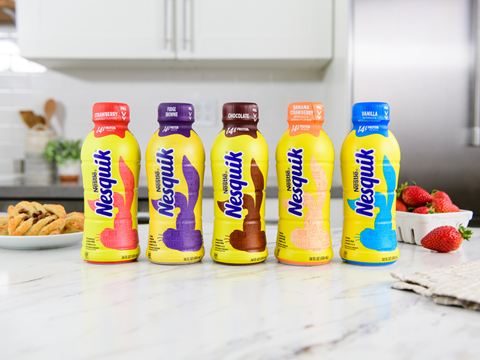
Nestlé has applied a new, recyclable shrink sleeve label with light-blocking print technology to its ready-to-drink Nesquik portfolio, aiming to help consumers recycle 4,500 metric tons of PET every year while maintaining product quality.
Apparently, the shrink sleeve does not need to be removed before disposal and can be recycled together with the bottle and cap. In turn, it is hoped that the recyclate will be implemented into another PET bottle and contribute towards a circular economy for plastic packaging.
With all seven of Nesquik’s ready-to-drink flavours set to adopt the sleeve by June 2024, Nestlé aspires to streamline the recycling process for its consumers and ensure that recycling facilities can sort its packaging more accurately.
“Our beverage division continues to be a leader in delivering high-quality, innovative products for our consumers, while also driving progress on Nestlé’s sustainability ambitions,” said Daniel Jhung, president of Nestlé USA’s beverage division. “It’s exciting to see Nesquik at the forefront of this packaging innovation. Making our products easier to recycle is important to our customers and consumers, and a key step in helping chart a path to a circular economy for packaging.”
In order to protect the light-sensitive qualities of the product – namely its taste, colour, and vitamin level – the sleeve needed to provide light-blocking qualities. Nestlé claims that, when it first sought to implement recyclable sleeves for its Nesquik bottles in 2019, a solution offering both light-blocking features and recyclability was not yet available.
Over five years of R&D, the company conducted multiple tests to ensure the technical viability of its own solution. Over 20 candidate materials underwent light transmittance tests, it explains.
Recyclability tests were also carried out to make sure the sleeve and the inks used to print it would still be compatible with the US recycling system; more specifically, that the sleeve bottle would sort correctly at recycling material recovery facilities, and that the sleeve inks would wash off to produce clean recyclate.
Additionally, factory trials sought to guarantee that the new sleeve would run effectively on Nestlé’s factory production lines, with adjustments made when necessary. Different versions of shrink sleeve artwork and ink combinations were tested to ensure that the sleeve ‘maintained Nesquik’s authentic look and feel’.
“Packaging protects food and beverages and helps ensure our products remain high-quality for our consumers,” said Chastity McLeod, VP Sustainability, Nestlé North America. “It was essential to find a solution that would maintain the quality and shelf life of the product, while also offering the benefit of making recycling the bottle easier for consumers.
“Our teams are constantly innovating to extend the use of packaging materials as a valuable resource that can be leveraged again—This innovation is a big step forward as we continue to drive progress on Nestlé’s packaging ambitions across our U.S. portfolio.”
All of Nesquik’s ready-to-drink bottles are set to adopt the new shrink sleeve by the summer. Some of the company’s Coffee mate and natural bliss product packaging will feature the new sleeve, while Nestlé Sensations flavoured milk products are scheduled to follow suit in early autumn.
A previous collaboration saw EMSUR, Siegwerk, Karlville, and SK microworks join forces under the collaborative #SleeveConnect project to develop a CPET shrink sleeve label for colourless rPET bottles. It is intended to enhance shrink sleeve technology and contribute to a fully recyclable packaging solution.
Innovia Films has also produced a low-density white polyolefin shrink film that is claimed to keep its floatability when it is printed – aspiring to improve the recyclability of food-grade PET packaging.
If you liked this story, you might also enjoy:
The Brief: How viable is biorecycling for plastics?
Report: How the top brands are progressing on packaging sustainability
The Brief: Using ocean-bound plastic in packaging – how, why and should we?


















1 Reader's comment